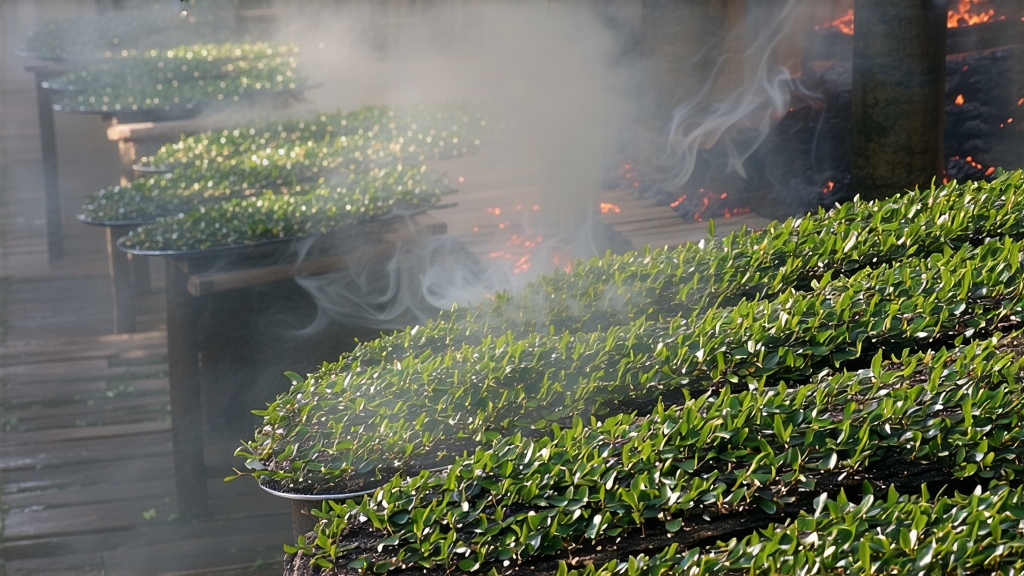
Long before Assam, Ceylon, or Earl Grey entered the global lexicon, the first fully oxidized leaf that would later be called “black tea” was born in the rugged Wuyi Mountains of northern Fujian. Locals simply named it “zheng shan xiao zhong”——“small-leaf variety from the original mountain.” European traders, struggling with the Minbei dialect, rendered the term “Lapsang Souchong,” and the smoky, wine-dark liquor they carried home would reshape the world’s morning ritual. Today, this tea is celebrated both as the primogenitor of every black tea on Earth and as a living contradiction: a leaf that can be simultaneously rugged and refined, campfire and concert hall.
History: From Ming Dynasty Outlaws to London Drawing Rooms
Legend places the origin in 1646, when Qing troops pressed through Fujian. Retreating Ming soldiers, encamped among tea factories, hastened the drying of freshly picked leaves over available pine fires to prevent spoilage. The accidental smoke infusion proved wildly popular with the Dutch VOC, who bought every chest and shipped it to Amsterdam and, soon after, to the newly fashionable coffee-houses of Restoration London. By 1667, the East India Company listed “Bohea Souchong” at twice the price of green tea; Samuel Pepys mentions drinking it in his diary. The British passion for this assertive leaf drove them to pirate the plant, the craft, and finally the entire industry, planting estates in India and Ceylon in a bid to break China’s monopoly. Yet even as those gardens flourished, connoisseurs continued to pay premiums for the authentic Wuyi original, recognizing that terroir and smoke in symbiosis cannot be transplanted.
Terroir: Why Only Tongmu Can Be Called Zheng Shan
Chinese law restricts the geographic indication “zheng shan xiao zhong” to a 600–1,200 m micro-basin along the Tongmu River, a protected nature reserve where mist rises from swift, cold water and old-growth Masson pines scent the air with resin. The soil is a friable, mineral-rich tuff of weathered granite and volcanic ash; the diurnal swing can exceed 15 °C, coaxing slow growth and concentrating aromatics. Outside this 48 km² enclave, similar techniques produce “wai shan” (outer mountain) tea, but the resinous sweetness and cooling camphor finish are muted. Thus, every authentic Lapsang Souchong is a bottled slice of Tongmu’s fog and pine.
Cultivars: Three Leaves and a Bud, but Which Bush?
The traditional cultivar is the “cai cha” landrace group—small, shrubby bushes with narrow, serrated leaves that flush purple in early spring. In the 1980s researchers released Wuyi Qizhong CL-series clones selected for higher catechin and carotenoid content, giving a brighter cup and more stable smoke note. Organic gardens now interplant tea with mountain cinnamon and litsea trees whose bark and leaves naturally repel pests, adding subtle spice to the leaf chemistry. Farmers pluck only in late April and early May, waiting for the “first grain rain” when amino acids peak and the spring pine firewood is still resinous.
Craft: The Eight Stages of Smoke and Fire
- Withering: Fresh leaves are laid 3 cm deep on bamboo screens set over a gentle pine ember pit (28–30 °C) for 8–10 hours. The goal is 65 % moisture loss while absorbing volatile pinene and bornyl acetate.
- Rolling: Once limp, leaves are rolled for 45 minutes under light pressure to rupture cells; the sap oxidizes rapidly, turning from emerald to copper.
- Oxidation: Rolled leaf is piled in cedar-lined crates covered with wet cloths for 3–4 hours at 24 °C and 85 % humidity. Technicians sniff every 20 minutes; when the aroma shifts from apple to dried longan, the stage is complete.
- Pan-firing: A quick 220 °C tumble for 3 minutes halts enzymatic activity and sets the color.
- Rolling again: Tighter twists form the characteristic strip shape.
- Smoking: The signature step. A two-tier brick oven is fired exclusively with 40-year-old Masson pine roots whose resin has crystallized. Raw pin